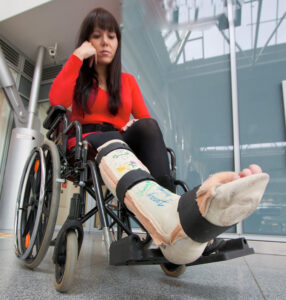 Case Studies
Case Studies
Can I Fly With a Broken Leg or Hip Fracture Abroad?
Can you fly with a broken leg? Or should you stay abroad for surgery? What if it’s a hip fracture? If you’ve broken a bone on holiday, it’s natural to want to come home—but flying with a cast or untreated fracture can come with serious medical risks.
Every year, thousands of British travellers face this decision. While it’s tempting to fly back to the UK for care, delaying surgery—even for a few days—can have serious consequences. In this guide, we explore the risks of travelling with a broken leg or hip fracture, the dangers of delaying surgery, and whether it’s safer to fly home or stay and be treated abroad.
What’s the Medical Risk of Waiting to Treat a Broken Bone?
When bones break, healing begins quickly. If not treated or aligned properly, a fracture can worsen. The NHS advises that broken legs and hip fractures be treated promptly to avoid life-altering complications.
One common scenario involves an older adult who sustains a hip fracture abroad (commonly a NOF fracture). UK guidelines advise that surgery should occur within 36 hours. Any longer and the risks of DVT, PE, infection and poor healing rise dramatically. It’s not uncommon for families to wait to fly home—only to find that the delay has caused a relatively treatable injury to become life-threatening.
Other risks of delaying surgery include increased pain, immobility, joint stiffness, pressure sores, or the bone healing incorrectly (known medically as malunion). For injuries like broken legs, experts warn that flying home can extend the delay beyond the critical 4-day window recommended in UK fracture care pathways.
Why Flying Home With a Broken Leg or Cast Isn’t Always Safe
 Flying with a broken leg or travelling in a full cast may sound manageable—but medically, it can be anything but. Your ability to sit, the type of fracture, and even airline restrictions all matter. Most commercial airlines won’t allow you to fly with a full-leg cast unless it’s been split, due to swelling risks at altitude.
Flying with a broken leg or travelling in a full cast may sound manageable—but medically, it can be anything but. Your ability to sit, the type of fracture, and even airline restrictions all matter. Most commercial airlines won’t allow you to fly with a full-leg cast unless it’s been split, due to swelling risks at altitude.
Prolonged sitting raises the chance of clot formation. Swelling from cabin pressure can make casts dangerously tight. And if your leg must remain straight, you may not fit in a standard seat—sometimes requiring extra seating or special arrangements. Flying with a fracture can result in worsened pain, dislodgement, or even emergency diversion mid-air.
Options for Medical Repatriation With a Fracture
If flying with a broken bone, especially a broken leg or hip fracture, you have several other options:
- Air ambulance: Best for critical or complex cases. Full medical team on board.
- Stretcher flight: A commercial aircraft with seats removed for stretcher space.
- Medical escort: For patients who can sit upright but need supervision and support.
- Ground ambulance: Useful in mainland Europe for those unable to fly.
Can You Fly With a Hip Fracture or Broken Leg Safely?
If you do choose to fly home with a broken leg or hip fracture, preparation is key. Your limb must be stabilised, pain managed, and you must have medical clearance (fit-to-fly letter). Some airlines require a split cast. For longer flights, compression stockings and DVT prevention medication may be recommended. Hydration is crucial, as is planning for airport transfers and assistance.
Never assume you can simply board and fly. Every case is different, and without medical advice, you could risk re-injury or serious complications.
Flying Home or Staying Abroad – What’s the Right Choice?
If your fracture is stable, well supported, and you’re medically cleared, then flying home may be reasonable. But if you’re dealing with a complex injury like a displaced hip fracture or cannot safely sit upright, treatment abroad might be safer—and faster. Discuss this openly with the treating hospital, your insurer, and a specialist repatriation team.
Final Thoughts
Delaying surgery for a fracture—especially a broken leg or hip fracture—can significantly affect your recovery. If you’re asking “Can I fly with a broken leg?“, the answer is: maybe—but only with the right precautions, support, and timing.
“We contacted Craig at 4 am ( UK time) and by 10 pm I was home. Ground ambulance to airport, air ambulance to the UK and ground ambulance home. Everything went smoothly, fabulous medical care and kindness. After a miserable two weeks in hospital in France I felt I was in the safest and most caring hands. I cannot thank Skycare enough.”
Reviewed by Dr Lee Collier – SkyCare Repatriation on 21/06/2025 | next review due 21/06/2027 | published on 21/06/2025
Let Our Medical Team Guide You — Before You Book That Flight
Still Unsure If You Should Fly Home With a Broken Bone?
Speak to a Clinician Before Flying With a Cast or Fracture
If you’re injured abroad and wondering “Can I fly with a broken leg?” or worried about delaying surgery for a fracture, our experienced medical team can help you decide the safest option.
We regularly assist patients flying home with hip fractures, leg casts, or broken bones sustained on holiday. Whether you need air ambulance support, a stretcher flight, or medical clearance guidance, we’ll help you plan the journey that puts your health first.
Contact Our Medical Repatriation Team
Free Quick Quote
 SkyCare
SkyCare 